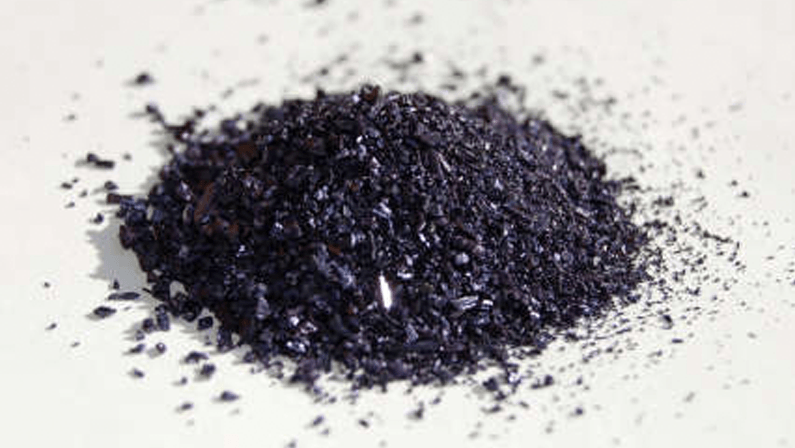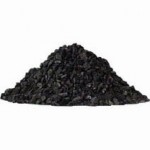Pyrolox Iron Filter Media for Iron Removal in Well Water Systems

Pyrolox is a granular water filter media that is manufactured and processed by Prince Minerals. It used in Iron Filters for the removal of Iron, Hydrogen Sulfide, and Manganese.
This article will cover what Pyrolox is and how it works. We will also highlight an example of how it could be used in a whole house iron filter for well water.
It’s important to remember that filter media is only one component of an Iron Filter. Pyrolox, like KDF is exceptionally heavy, and very hard to maintain. If great care is not taken, a system can fails quickly, and costs $1000’s to maintain or replace.
What is Pyrolox?

Pyrolox is an NSF certified natural mineral form of Manganese Dioxide. This granular filter media is black in color and is extremely dense.
This natural mineral is sold under the name of Pyrolox, Filox, or MetalEase. These 3 products are identical and share the following characteristics:
Pyrolox Filter Media Specifications
| Service Flow Rate | 5gpm/sq. ft. |
| Backwash Flow Rate | 25-30gpm/sq. ft. |
| Density | 120lbs/cu. ft. |
| Average Life | 10-12 years |
How does Pyrolox compare to Greensand, GreensandPlus, and Birm?
Pyrolox is a pure granular form of Manganese Dioxide. Greensand, GreensandPlus, and Birm are manufactured by coating a mineral like silica with Manganese Dioxide. As you can see below, the percentage of Manganese Dioxide varies greatly between these products:
Filter Media Comparison
| Pyrolox | 75% – 85% Manganese Dioxide |
| Greensand and GreensandPlus | 0.5% Manganese Dioxide |
| Birm | < 0.01% Manganese Dioxide |
How does Pyrolox Work?
Dissolved Hydrogen Sulfide, Iron, and Manganese cannot be removed by a filter. They need to be oxidized and precipitate into larger “chunks” so they can be removed by a filter.
Pyrolox acts as a catalyst that oxidizes those contaminants as they come in contact with the filter media. Once oxidized, Pyrolox strains the contaminants out of the water.
Eventually the oxidized solids will coat the surface of the media and the oxidation capacity will be reduced. At this point, a powerful backwash is needed to clean the media off. If the cleaning is not complete, the oxidation process will not continue and the filter will stop working.
Most filters backwash every 2-3 days, but Pyrolox MUST BACKWASH EVERY DAY to continue operating.
Pre-Treatment Recommended, But Not Always Required
While Pyrolox may act as a strong enough oxidant on its own, the use of additional pre-treatment is usually recommended if iron is over 2ppm. The same is true with Hydrogen Sulfide and Manganese.
An oxidant feed will improve both the removal performance and removal capacity of Pyrolox.
Chlorine injection into a retention tank up stream of the filter is the preferred oxidation method. Other acceptable oxidants include air injection and potassium permanganate.
Hydrogen peroxide is specifically prohibited for use as an oxidant.
Pyrolox Iron Filter Example
Let’s say your family needs to be able to operate two sinks at once, and has a flow rate requirement of 5gpm (gallons per minute). If you have marginally poor water with 1.5ppm of Iron and no other contaminants, you could use a simple backwashing filter – WITHOUT PRE-TREATMENT.
A 13” diameter filter has 0.92 sq. ft. of surface area. Pyrolox’s service flow rate is 5gpm, so a 13” filter would provide4.6gpm of filtered water (0.92 x 5). So far, so good.
Here’s where Pyrolox has problems:
Pyrolox requires a MASSIVE 30gpm backwash and rinse rate. In comparison, our Iron Curtain systems require 11gpm.
Pyrolox also requires DAILY regenerations!
This means that a 13” diameter filter will require 27.6gpm to backwash and rinse. The system would use 359 gallons of water to regenerate EVERY DAY. That is A LOT OF WATER for any drain to take!
A better system would use (3) 8” diameter filter vessels plumbed in parallel. This system would deliver 5.2gpm of filtered water, and only require 10.5gpm to backwash. The total water usage for all three systems would increase to 410 gallons, but the slower discharge would be much easier for a drain to take.
Iron Filters fail from inadequate backwash more than anything else. A system will plug up in a matter of months if the system can’t deliver the required amount of water to flush itself out!
Pyrolox’s huge water requirements make a proper backwash almost impossible to achieve.
Summary
Pyrolox is pretty slick when water chemistry allows the system to work without pre-treatment. That being said, most water in the Twin Cities has too much Iron for a Filter-Only system to work.
Like KDF, Pyrolox’s extreme backwash requirements make it almost unusable. A much simpler Iron Curtain filter system, with fewer but larger tanks, could achieve better filtration with a smaller footprint, and FAR LESS water use.
Who We Are
Premier Water is a local, family-owned water treatment company based in Chanhassen, MN. Since 1978, Premier Water has successfully implemented 1000’s of Residential and Commercial Filters and Purification Systems. We offer a FREE WATER TEST to gather information and help our clients with the right solution for their needs. We can also be reached at (952) 479-4553 for more information.

I use 3000 gallons/day. I have 3 ppm iron. I have 2.5 cu ft of media containing pyrolox and greensand. What should be my backwash time and frequency?
Greensand and Pyrolox have very different backwash rates. You would be better off using Greensand alone with a chlorine feed and a retention tank. Daily regenerations would most likely be required based on the volume of water you are using. What size of mineral tank are you using?
Hello;
I have a iron and sulfur problem with my well water.
Presently using a water softener (do not have hard water) misled by all those experts out there. Works good removing the iron but not the sulfur smell.
Can you help and i don’t want to use a chlorine injection system.
just thought I’d give you a try as a lot of those so called “experts” don’t even answer their E/m or info sites.
Yes, unfortunately water softeners get “sold” offering magical benefits they may not deliver. This is a shame, because water softeners offer great value and benefit (for what they actually do).
The “smell” could be sulfur gas, or it could be bacteria-related (Iron, Manganese, or Sulfur).
If you test for hydrogen sulfide gas and find none, then the problem is probably bacteria related.
Check out this link:
http://www.premierwatermn.com/water-quality/water-contaminants/iron-bacteria/
Thanks for stopping by!